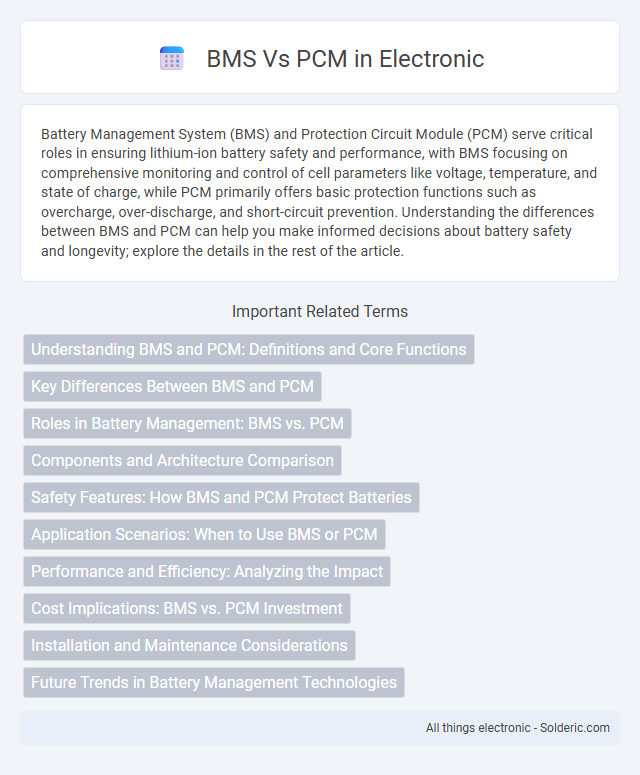Battery Management System (BMS) and Protection Circuit Module (PCM) serve critical roles in ensuring lithium-ion battery safety and performance, with BMS focusing on comprehensive monitoring and control of cell parameters like voltage, temperature, and state of charge, while PCM primarily offers basic protection functions such as overcharge, over-discharge, and short-circuit prevention. Understanding the differences between BMS and PCM can help you make informed decisions about battery safety and longevity; explore the details in the rest of the article.
Comparison Table
| Feature | BMS (Battery Management System) | PCM (Protection Circuit Module) |
|---|---|---|
| Function | Monitors and manages battery performance, safety, and lifespan | Provides basic protection against overcharge, over-discharge, and short circuit |
| Complexity | Advanced system with multiple sensors and control algorithms | Simple circuit focused on protection mechanisms |
| Control | Active balancing, state-of-charge (SOC) and health (SOH) monitoring | Passive protection without active battery management |
| Application | Used in electric vehicles, energy storage systems, and high-capacity batteries | Used in small batteries like Li-ion cells for portable electronics |
| Cost | Higher cost due to functionality and complexity | Lower cost, simple protection circuit |
| Output | Data communication and battery control signals | No data output, only circuit interruption for protection |
Understanding BMS and PCM: Definitions and Core Functions
Battery Management System (BMS) and Protection Circuit Module (PCM) are critical components for lithium-ion battery safety and performance. BMS manages battery health by monitoring voltage, current, temperature, and state of charge, ensuring optimal operation and longevity. PCM primarily focuses on basic protection functions such as overcharge, over-discharge, and short-circuit prevention to safeguard battery cells from damage.
Key Differences Between BMS and PCM
Battery Management System (BMS) monitors and controls battery performance, ensuring safety, longevity, and optimal operation by managing parameters like voltage, current, temperature, and state of charge. Protection Circuit Module (PCM) primarily safeguards the battery against overcharge, over-discharge, overcurrent, and short circuit without providing detailed monitoring or balancing functions. Your choice depends on whether you need comprehensive battery management or basic protection for safe battery use.
Roles in Battery Management: BMS vs. PCM
Battery Management Systems (BMS) monitor and optimize battery performance by managing cell balancing, temperature regulation, and state-of-charge calculations, ensuring safety and longevity. Protection Circuit Modules (PCM) primarily focus on safeguarding batteries from overcharge, over-discharge, and short circuits without providing extensive performance analytics. Your choice between BMS and PCM depends on whether you need comprehensive battery management or basic protection for your battery pack.
Components and Architecture Comparison
Battery Management System (BMS) typically integrates advanced components like microcontrollers, voltage and temperature sensors, and balancing circuits to monitor and optimize battery health and performance. Powertrain Control Module (PCM) primarily consists of processors and input/output interfaces designed to manage engine and transmission functions, rather than focusing on battery-specific parameters. Understanding the distinct architectures of BMS and PCM helps you choose the right system for precise energy management or vehicle powertrain control.
Safety Features: How BMS and PCM Protect Batteries
BMS (Battery Management System) and PCM (Protection Circuit Module) both enhance battery safety but operate differently; BMS continuously monitors voltage, temperature, and current to prevent overcharging, overheating, and short circuits, ensuring optimal battery performance and lifespan. PCM provides fundamental protection by disconnecting the battery during overcharge, over-discharge, or short circuit events, preventing immediate damage or failure. Your battery's safety is maximized when a BMS offers advanced, real-time management while PCM acts as a reliable fail-safe mechanism.
Application Scenarios: When to Use BMS or PCM
BMS (Battery Management System) is ideal for complex energy storage systems requiring real-time monitoring, balancing, and safety features in electric vehicles, renewable energy setups, and grid storage. PCM (Protection Circuit Module) suits simpler battery packs where basic overcharge, over-discharge, and short-circuit protection are sufficient, such as in consumer electronics or small portable devices. Your choice depends on the complexity of your application and the level of battery management and protection needed.
Performance and Efficiency: Analyzing the Impact
Battery Management Systems (BMS) and Protection Circuit Modules (PCM) differ significantly in performance and efficiency impact, with BMS offering advanced monitoring, balancing, and fault detection to optimize battery life and safety. BMS enhances charge-discharge efficiency by dynamically managing cell voltages and temperatures, whereas PCM primarily provides basic overcharge, overcurrent, and short-circuit protection without active balancing capabilities. The integration of BMS in battery packs results in improved energy utilization and prolonged cycle life compared to the limited functionality and efficiency provided by PCM alone.
Cost Implications: BMS vs. PCM Investment
Battery Management Systems (BMS) typically involve higher initial costs due to advanced features like real-time monitoring, cell balancing, and safety controls, which enhance battery lifespan and performance. In contrast, Powertrain Control Modules (PCM) investment costs are generally lower but may lack specialized battery management capabilities, potentially leading to increased maintenance expenses over time. You should weigh the upfront expense of BMS against potential long-term savings from improved reliability and reduced battery degradation when selecting between these systems.
Installation and Maintenance Considerations
Installing a Battery Management System (BMS) requires integrating sensors and control modules directly into the battery pack, ensuring precise monitoring and balancing, which can demand expert knowledge and careful calibration. A Power Control Module (PCM) typically offers simpler installation with fewer components but may lack the advanced diagnostic features of a BMS, leading to less proactive maintenance. Your choice affects long-term upkeep costs and system reliability, as BMS units often enable predictive maintenance, reducing unexpected failures and extending battery life.
Future Trends in Battery Management Technologies
Future trends in battery management technologies emphasize enhanced integration of BMS (Battery Management Systems) and PCM (Protection Circuit Modules) for real-time monitoring, predictive maintenance, and improved safety protocols. Advances in AI-driven BMS enable smarter energy optimization and fault detection, while PCM innovations focus on faster response times and miniaturization for compact devices. Your choice between BMS and PCM will depend on the required level of intelligence and protection sophistication in next-generation battery applications.
BMS vs PCM Infographic

 solderic.com
solderic.com